Money as a guidebook or a journey through the wallet

Hello! Due to the workload, in recent months I have been sitting in the city all the time and I have no opportunity to go to the mountains. Therefore I decided to make some unusual topic – it is about Uzbekistan and its sights and use money as a travel guide instead of spent money for journeys.
On our national currency – Uzbek Sums is shown many historical and famous places of Uzbekistan. I found out that almost all I already visited. Well, I can use my own photos in this case J. Nice!
Uzbek banknotes change their shape and color. But as for me, the changes in the design of our banknotes did not do them any good. In addition, the efforts of our money designers created some inconvenience to me - I had to run around the city and take pictures of the missing sights. On the other hand, there is a new reason to travel around the country. Although the reason has appeared, but there is still no opportunity yet - it is not possible to escape from the city.
Well, let's start the story? To begin with, I am an avid numismatist and all of the following banknotes are present in my collection. When preparing this post, I was going to scan banknotes, but unfortunately, the pictures came out somehow faded and overexposed. Tried to take a picture but due to the wrong light, the quality of the photos was terrible. Therefore, I had to borrow images of banknotes from the website of our Central Bank. Therefore, do not be confused by the inscription "Namuna" (Uzbek. "Sample") - but the banknotes look just right :).
After the collapse of the USSR, we still used Soviet rubles for some time. Then we used the so-called sum-coupons - transition money between the Soviet ruble and the already full-fledged Uzbek sum. Although ... given the rate of devaluation of the Sum, it is difficult to call it a full-fledged one. My childhood memory is that I am seven years old going with a heap of these sum-coupons and cut-off coupons to the grocery store. There, a saleswoman, armed with scissors, cuts out the required quantity of coupons and only then releases the goods. Well, okay, but we lived merrily and there was always snow on New Year's. Not like now - December 31, the temperature in Tashkent was +16 degrees :).
So, in 1994, Uzbekistan introduced into circulation its national currency - the Uzbek sum. In the beginning there were denominations - 1, 3, 5, 10, 25, 50 and 100 Sums. Plus "penny" – in Uzbek language “tiyins”. At first, one sum could buy a loaf of bread or two chewing gums. True, it was not possible to buy such a set for a long time - the money began to rapidly depreciate ...
1 sum - State Bolshoi (Grand) Academic Theater named after Alisher Navoi (Tashkent)
The banknote of 1994 is made in green and pink tones. A tiny piece of paper (compared to a 100-thousandth bill) with a size of 120x62 mm. This banknote depicts the heart of the cultural life of Tashkent - the State Academic Bolshoi (Grand) Theater named after A. Navoi. This denomination has been withdrawn from circulation.
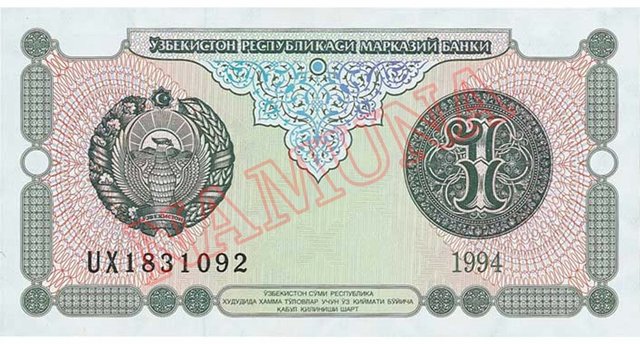
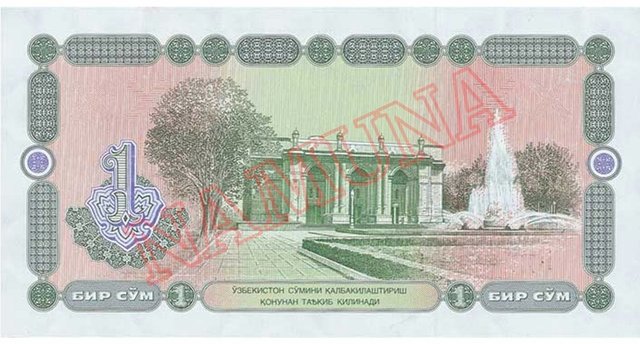
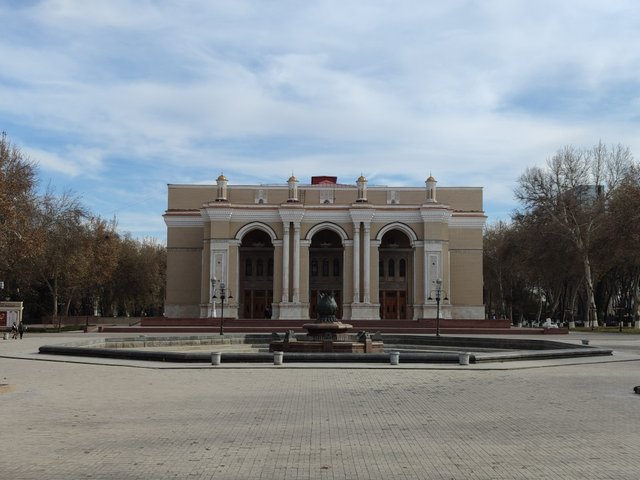
The building was designed by the legendary architect Alexei Shchusev. This architect designed the Vladimir Lenin’s Mausoleum on the Red Square in Moscow. The construction of the Bolshoi Theater began in 1939, but in 1942. was suspended due to the World War II. However, despite the difficulties of wartime, the Soviet leadership still managed to find funds and in 1944 construction continued. Speaking of the "bloody Soviet legacy" - during the years of the most destructive war in the world, it was still possible to supply the front and build theaters. But now, in well-fed and peaceful years, theaters somehow fail to build. Even repairing them is not particularly successful ... More and more shopping centers and hotels are being built ...
However, in 1948 the theater was completed, including by the forces of captured Japanese soldiers from the Kwantung Army. The theater has 6 foyers - each of which reflects the peculiarities of the architecture of the regions of Uzbekistan. There is a color and musical fountain in front of the theater, and Open Air concerts were held on the square in front of the theater in times before COVID-19. I've visited one of them - a great event!
As already mentioned, Japanese prisoners of war took part in the construction of the theater building. Many will probably be surprised, but those Japanese have retained a good memory of Tashkent and ex-Prime Minister of Japan Shinzo Abe, who was present at the opening of the building after reconstruction in 2010, cordially thanked the Uzbek people for the mercy and participation shown to his compatriots in those years. Incidentally, surprisingly, the Japanese soldiers not only did the hard work, but they were also entrusted with decorating part of the building. So, the famous brickwork is their business. And the patterns of the Bukhara, Khiva and Kokand theater halls are the fruit of joint efforts of Uzbek and Japanese artisans.
But By the way, what does a 1-Sum banknote look like compared to a 100-thousandth one.

3 sum - Chashma-Ayub Mausoleum (Bukhara)
Also a small banknote of 1994, size 120x62 mm. Made in red-brown and green-ocher colors. This denomination has been withdrawn from circulation.
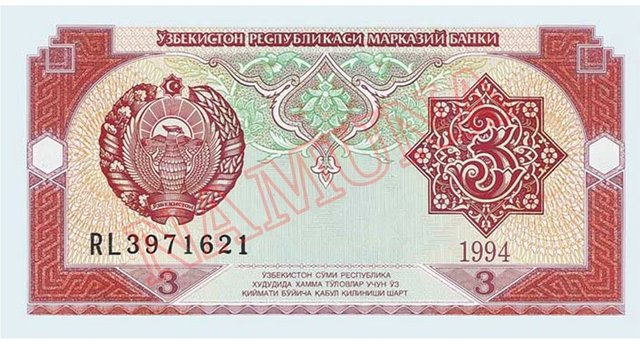
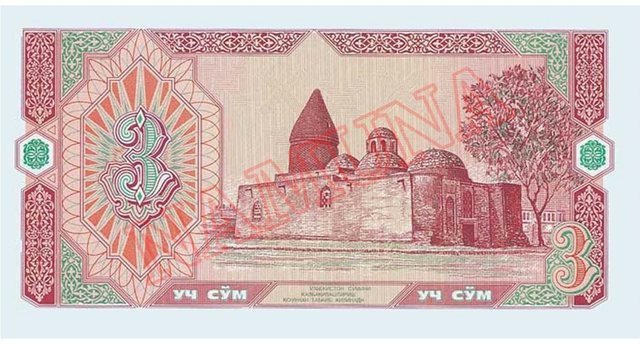
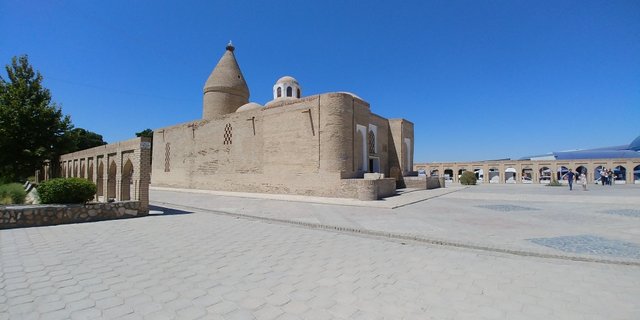
Directly visually conveys the heat that reigns in summer in Bukhara! This banknote depicts the historical monument of architecture "Chashmai Ayub" ("Source of Saint Job") in Bukhara. This religious building in the center of the historical part of Bukhara includes a mausoleum and a sacred spring. The mausoleum was built in 1379-1380 during the government of Tamerlane. There is a legend about this monument associated with the prophet Job (or Ayub), who allegedly traveled as a preacher through the Bukhara lands. During a drought, dying of thirst, the local people asked him for water and as soon as he hit the ground with his staff, a healing spring appeared, from which you can still drink fresh water. The Orthodox Church in Bukhara regularly reads akathists at the place of stay of the prophet Job.
Regardless of how true this legend is, the very existence of a historical monument associated with the name of the biblical character is a symbolic phenomenon that indicates the spread of the Bible and Christianity in these places in the distant past.
** 5 Sums - Monument to Alisher Navoi (Tashkent) **
Banknote of 1994. Size 142x69 mm. The predominant colors on the front side are blue and red-brown, on the back side - blue, green and purple. The banknote depicts a monument to Alisher Navoi, located in the National Park of Tashkent (more precisely, the pitiful remnants of what was called the National Park). From that National Park there is only one name left because on a large part of the park there is a tasteless shopping and entertainment complex Magic City in the style of "a la Disney". Because of this, I could not get close to the monument and photograph it from the desired angle ...
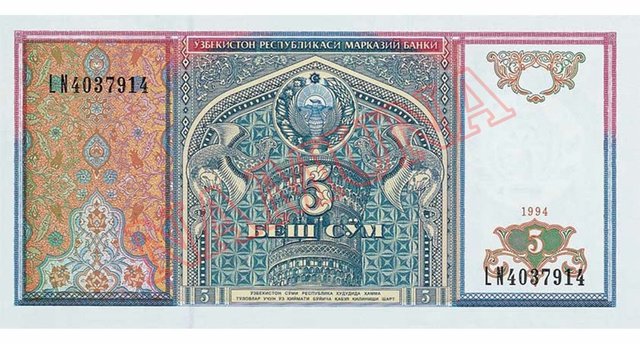
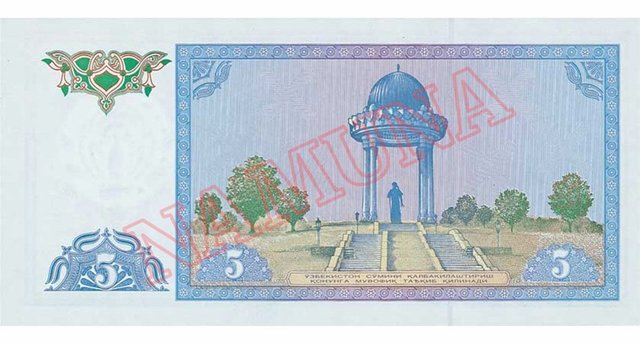
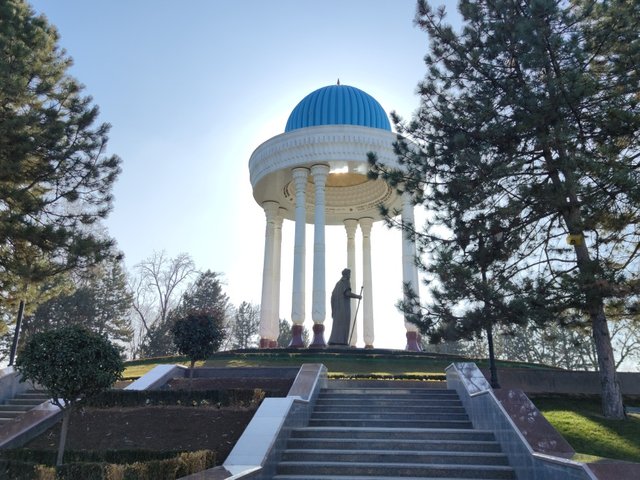
By the way, in 2014 the 5-sum banknote has been recognized as one of the most beautiful banknotes in the world. Alisher Navoi is a great poet of the medieval East. Navoi is a pseudonym and is translated as "melodic". The real name of the poet is Nizamaddin Mir Alisher, who had perhaps the same influence on the development of Uzbek and Uighur literature as Pushkin did on the development of Russian literature or William Shakespeare on the English literature.
Statesmen often try to combine their main activity with creativity. As a rule, nothing good comes of it. However, Alisher Navoi was an exception, while holding high government positions, he nevertheless managed to become a great poet and philosopher. His literary heritage is really huge - more than 3000 works. The work of Alisher Navoi had a tremendous impact on the development of Uzbek and Uyghur literature in the Chagatai language, as well as on the development of other Turkic-language literatures - Turkmen, Azerbaijan, Turkish, Tatar.
This denomination has been withdrawn from circulation.
10 Sums - Gur-Emir Mausoleum (Samarkand)
Banknote of 1994. The size of the banknote is 142x69 mm. The prevailing colors of the banknote on the obverse are violet, light violet, blue, cyan and ocher, on the reverse side - blue-cyan, violet and red-brown. This denomination has been withdrawn from circulation.
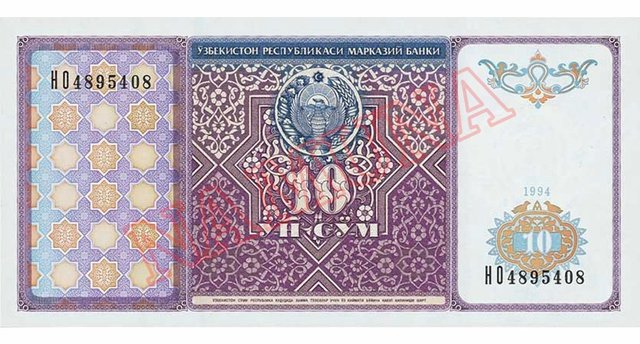

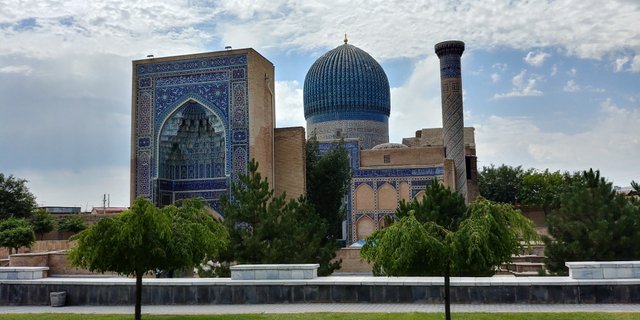

The banknote depicts the historical and architectural monument of the Temurid Mausoleum "Gur-Emir" in Samarkand. Gur-Emir - translated as the "Ttomb of the Ruler" and is the resting place of the mighty and formidable Tamerlane and his family members. Gur-Emir (since 2009 it is officially called the Tomb of the Timurids) was built in 1404 and occupies an important place in the world of Islamic architecture. By the way, Gur-Emir is the prototype of the famous Taj Mahal in India.
The dome and walls of the Tomb are covered with mosaics of glazed bricks with gilding and paintings. The picture is complemented by marble and onyx panels covered with painting, carving and inlaid with semiprecious stones. Of course, the tomb was overhauled and restored, but in some places, on the outer walls, there are still original glazed bricks of the XVth century.
More about Gur-Emir you read here
25 Sums - Shakhi-Zinda Mausoleum (Samarkand)
Banknote of 1994. Size 142x69 mm. The prevailing colors of the banknote on the obverse are dark blue, blue-green, violet-brown and green, on the reverse - blue-violet and light brown. This denomination has been withdrawn from circulation.
https: //c.radikal.ru/c41/2112/de/edc6f2cee29b.jpg
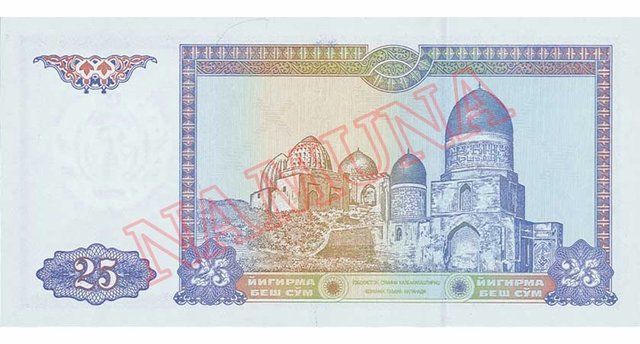
Photo of the landmark from a different angle.
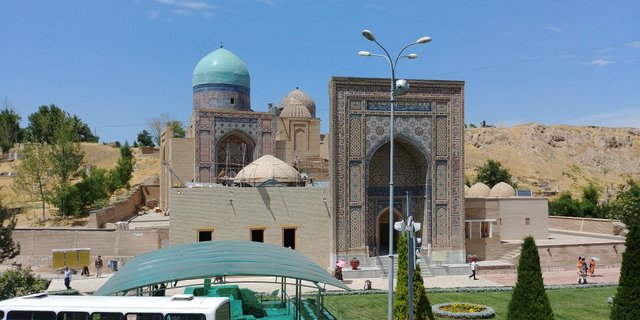
The banknote depicts the Shakhi Zinda historical and architectural ensemble in Samarkand. Shakhi-Zinda (literally "Living King") is a whole architectural ensemble of the mausoleums of the Karakhanid and Temurid nobility. Most of them were built in the XIV-XV centuries, but during the excavations they found the ruins of mausoleums dating back to the XI-XII centuries. The complex is included in the UNESCO World Heritage List.
According to an ancient legend, Kusam Ibn Abbas (a cousin of the Prophet Muhammad) preached Islam here and was beheaded by the Zoroastrians. After being beheaded, Kusama grabbed his head and hid in a well, where after drinking "living water" he received immortality. There is a 40-step staircase right at the entrance to the complex. According to tradition, you need to count the number of steps when going up and down. For a righteous person, the number of steps will coincide - for a sinner, no. I have been here several times - sometimes the number coincided, and sometimes not :).
I wrote about Shakhi Zinda few years ago,
50 Sums - Registan (Samarkand)
Banknote of 1994. Size 142x69 mm. The prevailing colors of the front side of the banknote are dark brown, red-orange, yellow and silver, the back side is light brown, brown, light blue, light purple and light green. This denomination has been withdrawn from circulation.
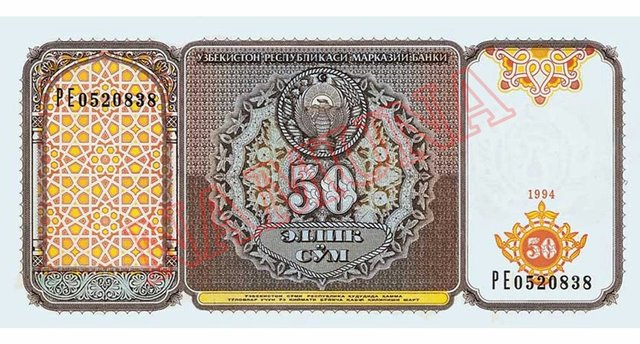
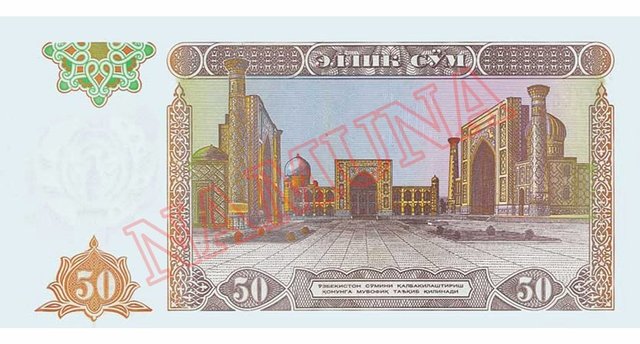
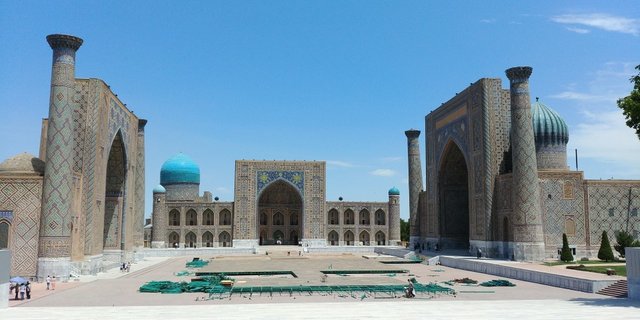
Actually, it was more correct to write Registan Square in Samarkand. Since any "front" square in the cities of the East was called a registan earlier. However, the word registan is now closely associated with the area of three madrasahs in Samarkand and has long become a proper name and is written with a capital letter.
If you face the Registan, then opposite will be the Tillya-Kari Madrasah, on the left is the Ulugbek Madrasah and on the right is the Sherdor Madrasah.
Ulugbek madrasah is the oldest madrasah of the ensemble. It was built in 1417-1420 by the ruler and scientist-astronomer Ulugbek. For many years this madrasah was the center of scientific thought in the East.
Opposite the Ulugbek Madrasah stands the Sherdor Madrasah - (Madrasah with lions) was built in 1619-1635 / 36, and almost mirrors it, although with some distortions in proportions. Although the building is called "Madrasah with Lions", the portal depicts animals that look more like tigers. But these are not tigers either - this is the coat of arms of Samarkand - fabulous animals - leopards with the sun on their backs. By the way, the Sherdor madrasah is most widely represented on our money - elements of this madrassah are on the 200-Sum banknote, as well as on the 5000 and 50,000 Sum banknotes.
The ensemble is completed by the Tillya-Kari Madrasah - translated as “madrasah decorated with gold”. Construction began in 1646. and completed in 1660. As the name suggests, the inside of the madrasah is richly decorated with gilding. By the way, the dome of the madrasah has an interesting feature that is not noticeable at first glance. Just think - the dome is convex, and, accordingly, its inner part is “convex”. And here it is not "convex", but flat. But thanks to the skillful pattern and ornament, the illusion of volume is created.
More about Registan you can read here
100 Sums - People's Friendship Palace (Tashkent)
Banknote of 1994. Size 142x69 mm. The prevailing colors of the front side of the banknote are dark purple, blue-green, ocher-gold and pink, the back side is purple, light blue-green. This denomination has been withdrawn from circulation.

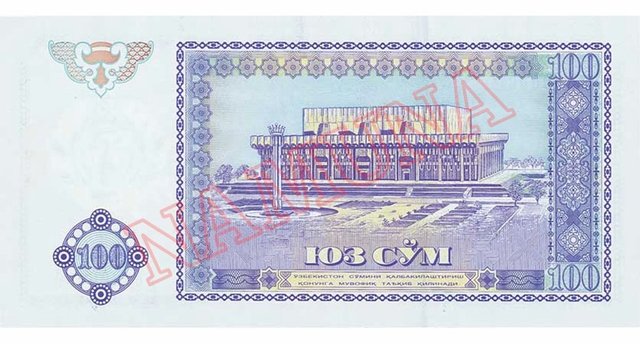
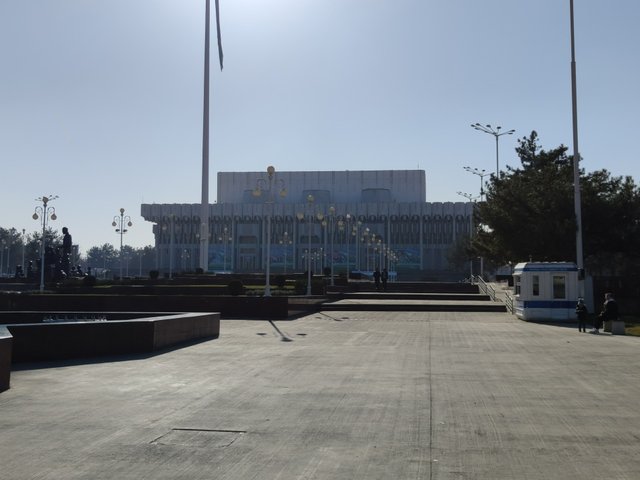
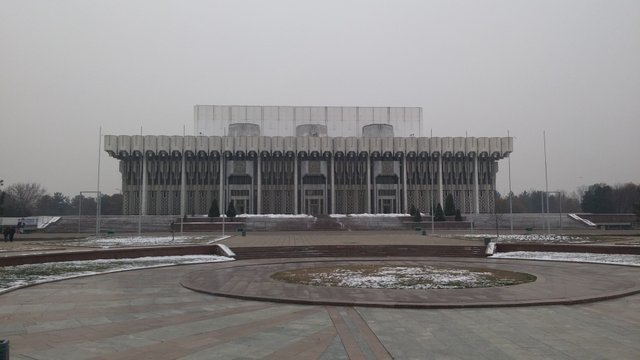
The banknote depicts the architectural ensemble of the Friendship of Peoples Palace. In the Soviet years, on the square near the palace, there was a monument to the family of the blacksmith Shamakhmudov, who during the World War II sheltered 15 children from the war-torn republics. During the years of independence, everything "Soviet" was actively etched away and the monument migrated to the outskirts of Tashkent. And the palace itself in 2008 from "Friendship of Peoples" turned into "Istiklol" (independence). Fortunately, 10 years later, it was decided to restore the previous name and return the monument to its rightful place. This is correct - after all, the history of the Shamakhmudov family very clearly demonstrates the friendship of peoples in deeds, and not in words.
Although the building is modern, like all monumental buildings in Uzbekistan, it was built with an eye on history and ancestors. The unique architectural form of the building is similar to the archaeological finds of Varakhsh and Kampir-Kala - the base of the building is a square, all four walls have the same decoration and design.
The total area is 12,000 square meters, the capacity is almost 4,000 people. It hosts concerts, international and republican forums, interstate meetings. For example, the first historic meeting of the heads of the CIS in May 1992. And when I was preparing this post, I was amazed to read that in 2018, a Scorpions concert took place here. How could I have missed such an event ?!
200 Sums - Lion (tiger) from the facade of the Sherdor madrasah (Samarkand)
Banknote of 1997. Size 144x78 mm. The prevailing colors of the front side are green-yellow, violet-brown, the back side is green-blue-orange. This denomination has been withdrawn from circulation.
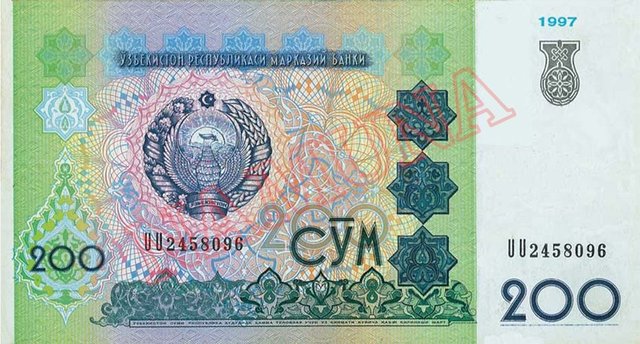
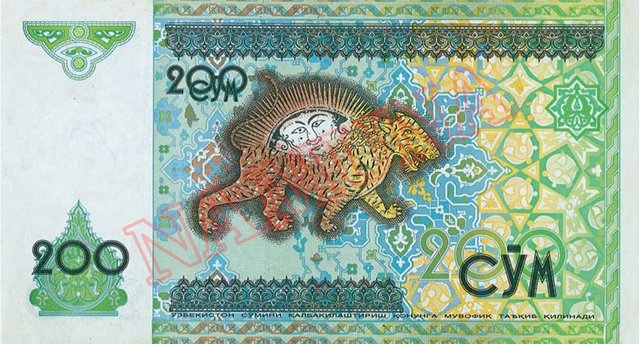
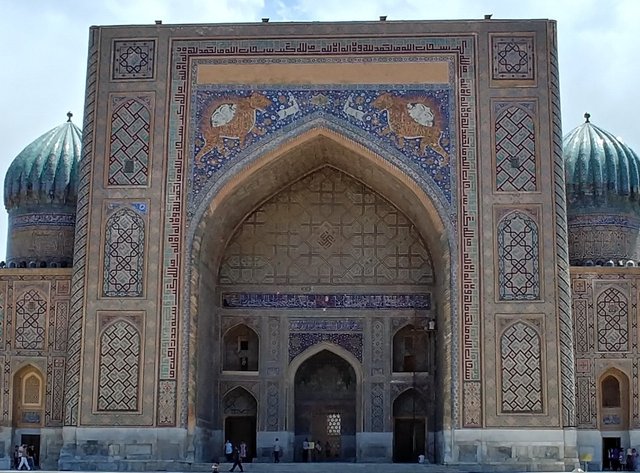
The banknote depicts a fragment of the facade of the Sherdor Madrasah (Madrasah with Lions) in Samarkand (an image of a leopard carrying the sun). No, I didn'joke - the name of the "Sherdor" madrasah really translates as "madrasah with lions" and not tigers, as it might seem. In general, these "lions" (which are not tigers) carrying the sun are actually leopards - a symbol of Samarkand. The history of Samarkand is so ancient (more than 2750 years) and so much is mixed here ... The Persians brought the lion symbol to Samarkand, and after the invasion of the Arabs and Turks, the lion symbol mixed with the symbols of the tiger and leopard, as well as the symbol of the Sun and finally you can see the result of “mix”on the portal Madrasah Sherdor.
** 500 Sums - Monument to Amir Timur (Tamerlane) in Tashkent **
Banknote of 1999. Size 144x78mm. The prevailing colors of the front side are light green, cherry, dark red and purple, the back side is dark red, green and blue. This denomination has been withdrawn from circulation.
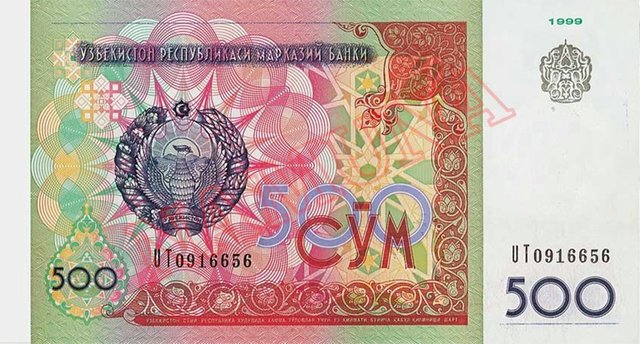
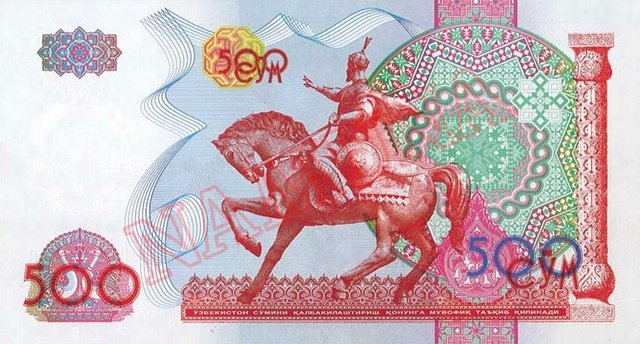
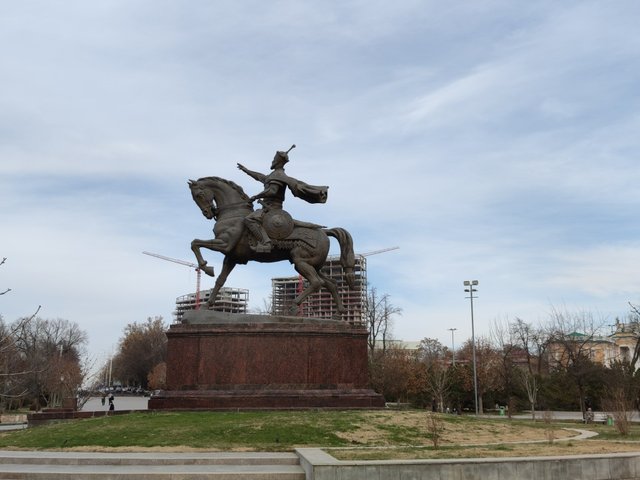
The banknote depicts a monument to Amir Timur (Tamerlane) in Tashkent. In fact, Amir Timur (as well as Tamerlane) is a pseudonym. His full name is Timur ibn Taragay Barlas. Amir Timur - literally "Timur the Ruler". Tamerlane is a distorted "Timur-e-Lyang" - "Lame Timur" or as often say - "Iron Lamer", since the name Timur comes from the word "temir" - "iron". Tamerlane was born in 1336, died in 1405. He was a great statesman who created a huge empire that included the territories of modern Uzbekistan, Turkmenistan, Tajikistan, Afghanistan, Pakistan, Iran, part of the territory of Azerbaijan, India, Iraq, Turkey, Kazakhstan, Kyrgyzstan and China.
Like all great people, Tamerlane was an ambiguous person. On the one hand, he patronized the development of culture, architecture and sciences in his empire, on the other hand, he mercilessly executed hundreds and thousands of recalcitrant inhabitants. On the one hand, he created a centralized state, brought order to his lands. There is a legend that even a child with a dish full of gold coins can go from one end of his empire to another and no one will touch him. On the other hand, he mercilessly destroyed cities, enslaved the population, making an exception only for artisans or scientists, pulling them out of their homes and bringing them to Samarkand or other cities of his great empire.
He created a centralized empire in which arts and sciences, architecture and painting flourished. He built cities, improved the irrigation system, and stimulated agriculture. He made Samarkand the center of Asian trade and most of the architectural monuments recognized by mankind as masterpieces of architecture belong precisely to the era of his reign. But the price of all this was high .... Nevertheless, he occupies a worthy place in the history of mankind and who knows, if it weren't for him, how would this story turn?
By the way, there is a spicy story about this monument - hotels are located around the park and the place near the monument was once chosen by ladies with "low social responsibility" who, under the supervision of pimps, offered their sexual services to foreigners. There was a period when our office was located nearby and in the evening I walked past this monument to the subway. A couple of times I was also offered to enjoy my time. Of course I refused :). After some time, information about these outrages reached the country's top leadership and the "ladies of the night" were dispersed.
1000 Sums - Timurid Museum (Tashkent)
The banknote of 2001. Size 144x78 mm. The prevailing colors of the front side of the banknote are blue, pale cherry, brown and purple, the back side is emerald, purple, green and blue. Today it is the smallest of the valid denominations.
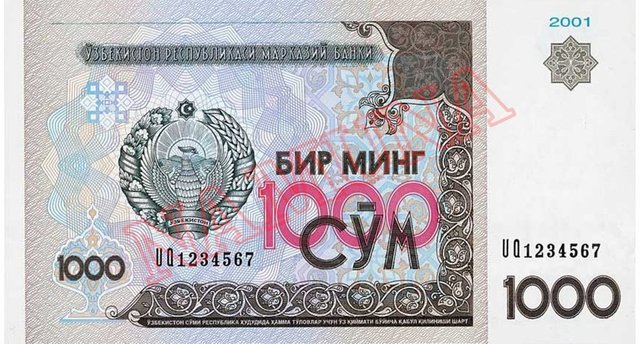
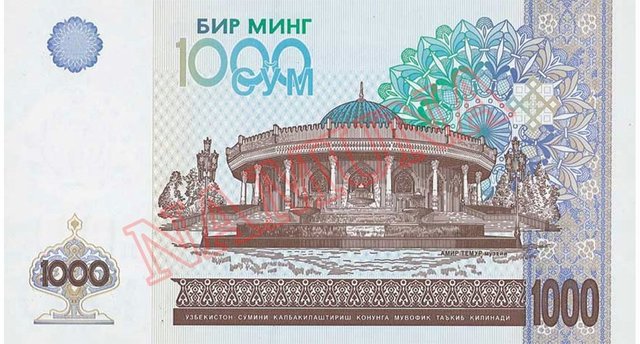
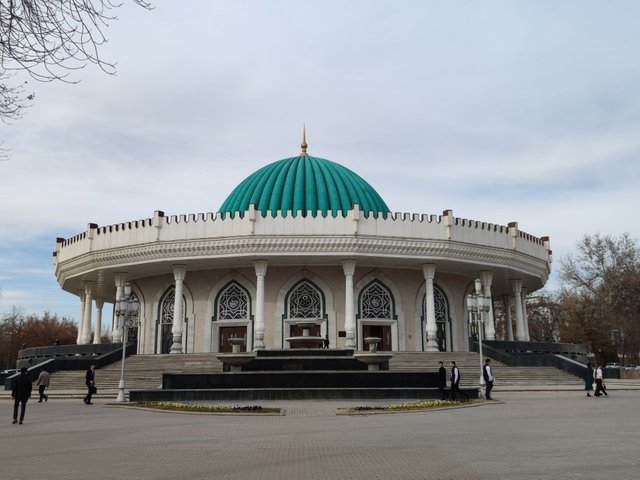
Perhaps one of the most "faded" banknotes, made mainly in lilac and brown colors. The banknote depicts the building of the Temurids Museum in Tashkent. The museum is dedicated to the reign of Tamerlane (Amir Timur) and his descendants - the Temurid dynasty. The museum was opened in 1996. which contains objects of that era. The museum resembles a tent with a classic oriental dome. The interior is richly decorated with marble, gold leaf, painting, miniatures the Turks. The exposition of the museum is dedicated to both Tamerlane himself and the era in which he lived. The exposition is constantly updated and it is very interesting there. One 8.5-meter chandelier is worth a lot!
2000 Sums - Entrance to Ark (Bukhara)
Banknote of the 2021 sample. Size 142x69 mm. The predominant colors of the front and back sides are magenta and light green.
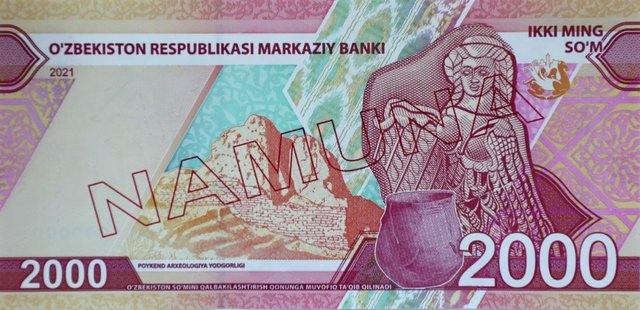
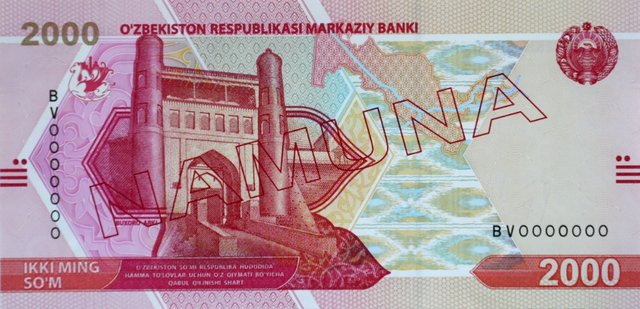
The front side shows the entrance to the ancient fortress Ark, erected in the I century BC and rebuilt in the XI-X centuries AD (the present view was formed in the XVI century AD).
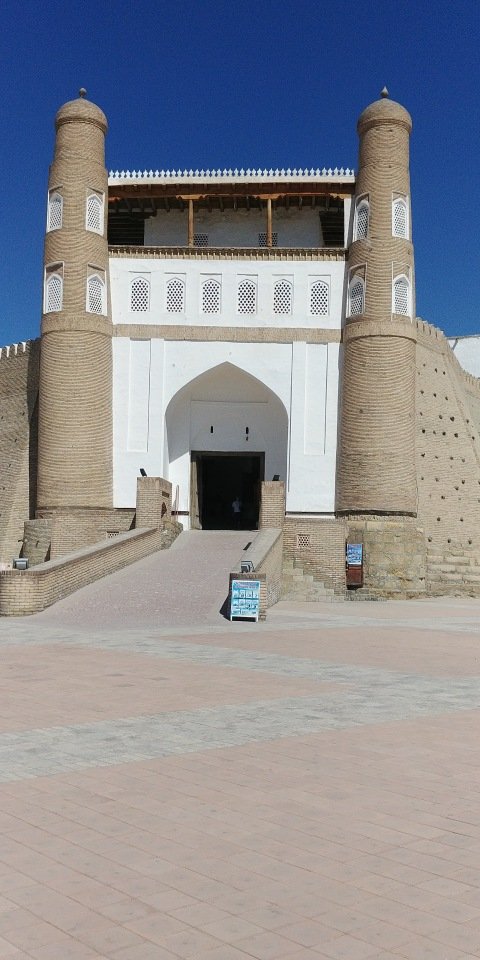
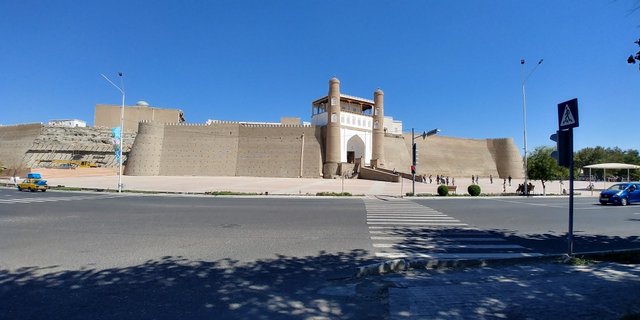
Ark is a very interesting building: its high sloping walls and powerful watchtowers seem to be taken from fantasy like "Game of Thrones". Such walls would surely withstand the onslaught of the dragons of Daenerys Stormborn...
There are a couple of legends associated with the construction of the Ark. The first of them tells how the hero of the ancient epic Siyavush fell in love with the daughter of the powerful king Afrasiab. To test the hero's IQ Afrasiab instructed him to build a palace that would fit within the bounds of a bull's skin. Siyavush possessed a bright, non-standard mind and wit: he cut the bovine hide into many thin strips, which he tied together, laid out on the ground and joined the ends. It was within these boundaries that Ark built.
The second legend is related to real facts. It is believed that the builder of the Ark was Bidun Bukhar Khudot - the ruler of Bukhara, in the IX century AD he tried several times to build a mighty fortress and each time the construction ended in failure. Finally, the sages told him to build a fortress on seven pillars, repeating the arrangement of the stars in the constellation Ursa Major. The ruler followed their advice and for tens of centuries Ark has guarded the peace of Bukhara.
With the expulsion of the last emir (governor) by the Bolsheviks, Ark turned from the residence of the rulers into an archaeological and cultural monument. Now on the territory of the Ark there are many museums. Like any citadel - Ark was intended to protect the ruler of his entourage. However, its thick walls did not always save their inhabitants. In 1220, Genghis Khan's troops broke into Ark and partially destroyed it. 700 years later, the greatest damage to Ark was caused by bombing from Soviet Army aircraft during the Civil War. Many modern sources emphasize in every possible way the role of the "Bolsheviks" and personally commander M. Frunze in the destruction of the Ark. However, in my personal subjective opinion, modern restoration does the fortress no less, and maybe even more damage.
5000 Sums (old) - the building of the Oliy Majlis (Parliament) in Tashkent
Banknote of 2013. Size 144x78 mm. The main color of the bill is green.
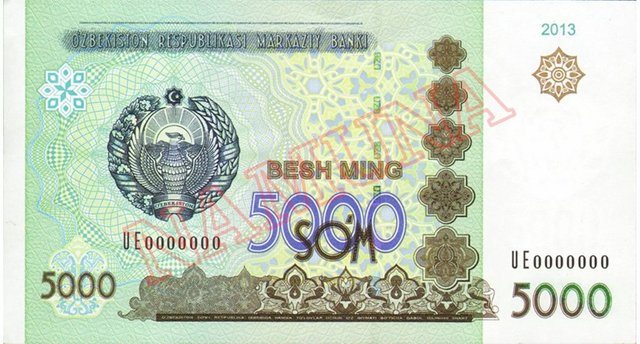
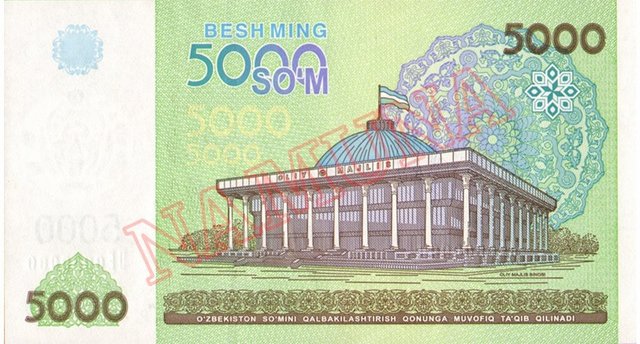
The banknote depicts the building of the Oliy Majlis (Parliament) of Uzbekistan in Tashkent. It is located on the territory of the National park of the Republic of Uzbekistan. The building of the Oliy Majlis is located exactly behind the Friendship of Peoples Palace.
It is a circular building 86 meters in diameter. The total area of the 4-storey building is 24 thousand square meters, the facade of the building along the entire perimeter is made of 36 snow-white corrugated columns, each 48 meters high. From the inside, the building is richly decorated in the national style. The painting of the dome is executed with golden "pillars" - an impeccable work of artisans and artists. The height of the hall is 32 m. The central chandelier is 10 m high and 7.5 m in diameter, made of 600 crystal elements and gold. The chandelier weighs 4.5 tons. Bukhara and Ukrainian granite, as well as marble from Samarkand and Italy, were used to decorate the facade of the building.
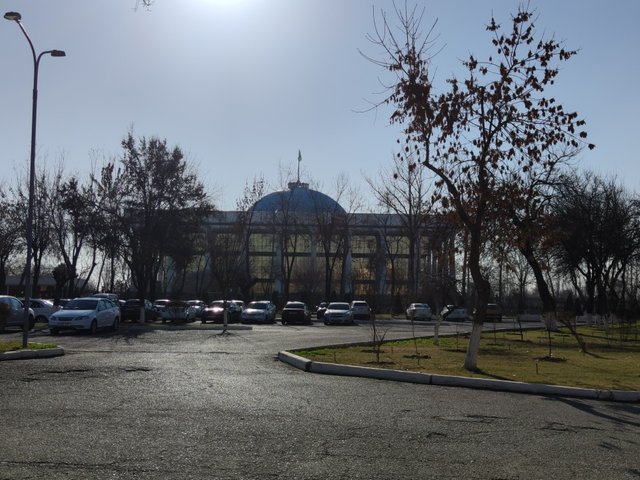
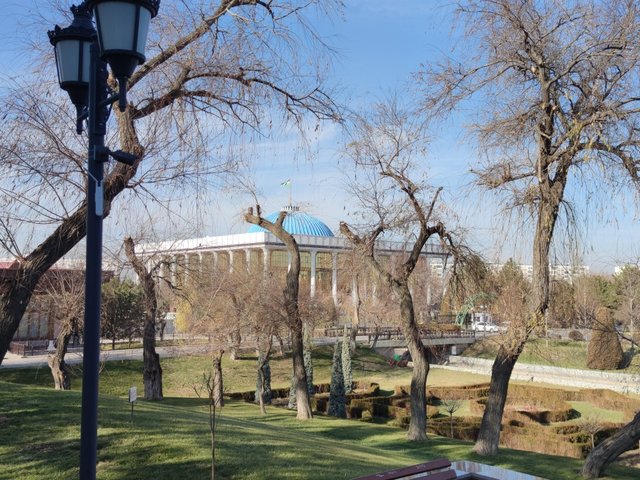
Unfortunately, it was not possible to get close to the building - the guards were on guard. Therefore, I had to take pictures from the side and did not succeed in taking a photo from the desired angle.
5000 Sums (new) - "Sherdor" madrasah (Samarkand)
Banknote of 2021. Size 142x69 mm. The predominant colors of the front and back sides are green and brown.
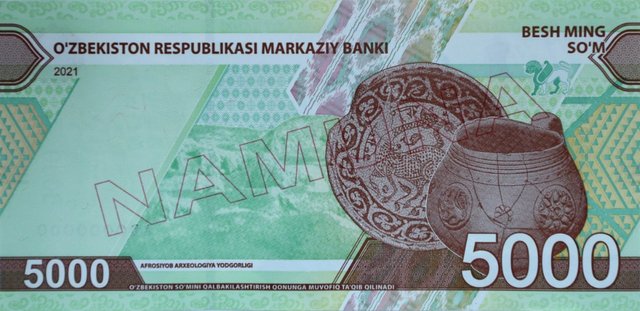
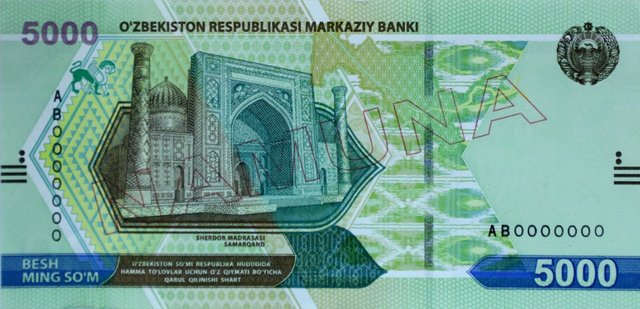
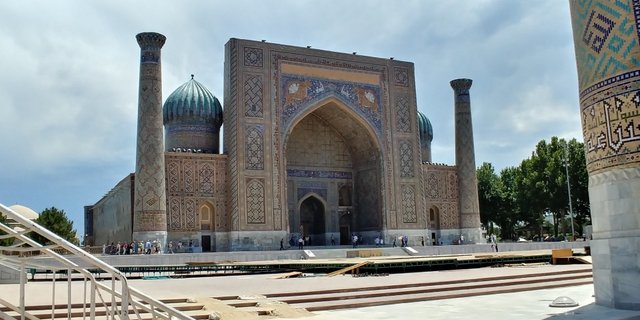
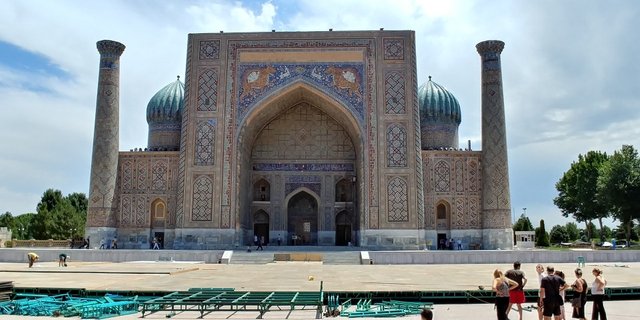
And again we are transferred to Samarkand. We did not have time to marvel at 2,000 and 20,000 Sum bills when the Central Bank rolled out a new update - this time it was decided to update 5,000 and 10,000 Sum bills. The banknote depicts the Sherdor madrasah, but I have already written about it above.
10,000 Sums (old) - Administration of the President of the Republic of Uzbekistan (Tashkent)
Banknote of 2017. Size 144x78 mm. The predominant colors are dark blue, blue, pink.
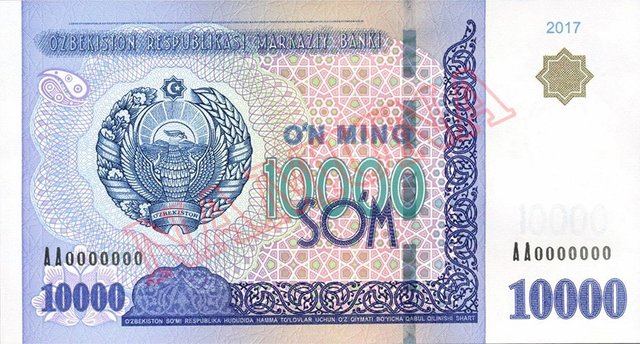
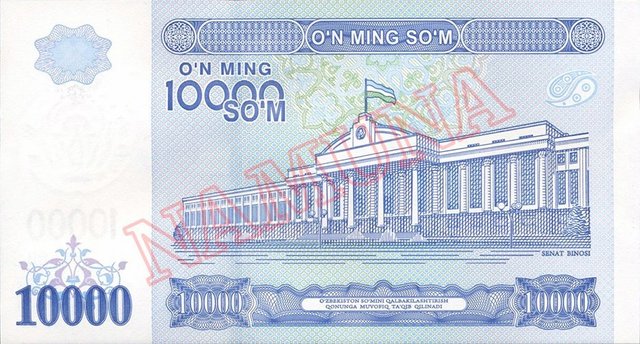
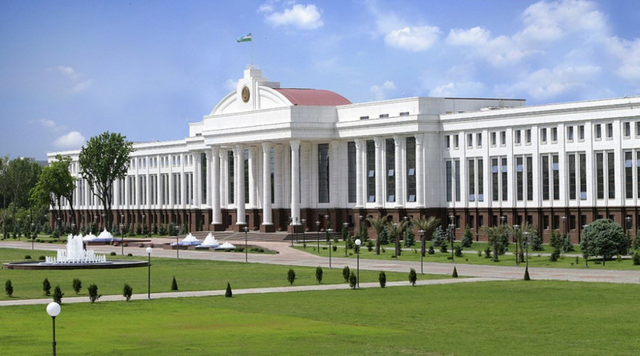
It's funny to call this banknote old - after all, it was introduced into circulation only about 4 years ago - in 2017. Nevertheless, it is gradually being withdrawn from circulation, replaced by a new "ten". The building depicted on the banknote is the least historic of all. This is the current Administration of the President of Uzbekistan, and before that it was the building of the Senate of Uzbekistan.
Besides the fact that this is a hefty pretentious building (somewhat similar to the "White House" in Washington) and there is nothing to say. Well, we will not say anything. Since the building is terribly guarded, I could not get close to it. I had to look for photos on the Internet.
10,000 Sums (new) - Kukeldash madrasah (Tashkent)
Banknote of 2021. Size 147x69 mm. The predominant colors of the front and back sides are blue, purple and pink.
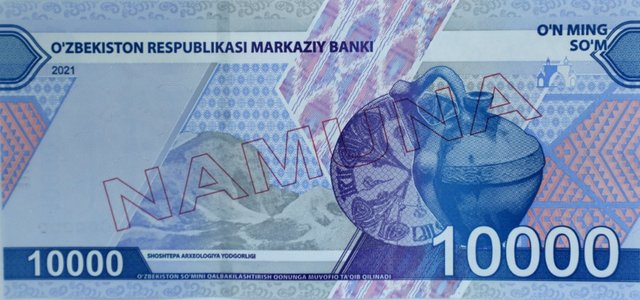
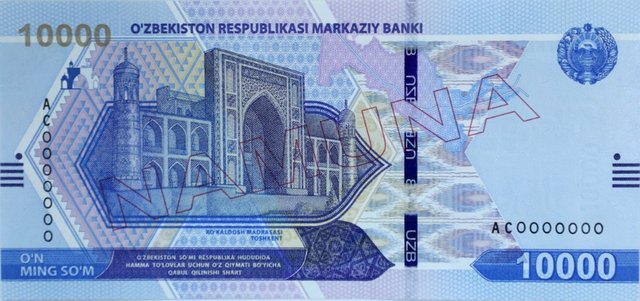
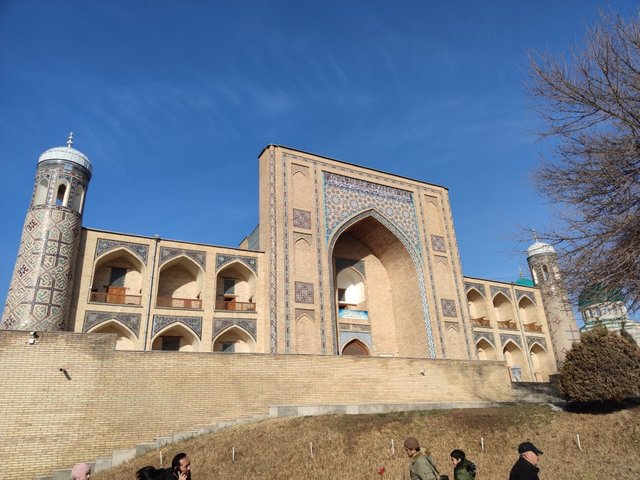
The Kukeldash madrasah is the largest of the 23 madrasahs of old Tashkent, built no later than 1569 by the minister of the Tashkent Sheibanid sultans Barak Khan and Dervish Khan, who bore the nickname “kukeldash”, which means “milk brother”.
The madrasah was badly damaged by the devastating earthquakes of 1866 and 1886. The building acquired its present appearance after restoration in the 1950-60s.
Initially, "Kukeldash" was conceived and used as a madrasah - an Islamic religious educational institution. Later, in the XVIIIcentury, it was used as a caravanserai, then it was a fortress of the Kokand rulers. In the 1830s, the dome and the second floor of the cell rooms were dismantled into bricks for the construction of other buildings.
A full-fledged restoration was completed after the collapse of the Soviet Union. During the restoration, photographs from the 1880s were used. Thus, the present exterior appearance of the building is quite different from the original one.
For some time, the building of the madrasah was used as a museum of Uzbek national instruments and only relatively recently it was returned to the role of a religious educational institution.
20,000 Sums - construction of Koy-Krylgan-kala (Karakalpakstan)
Banknote of 2021. Size 147x69 mm. The predominant color of the front and back sides is blue, purple, brown.
Since Koy-Krylgan-kala is located in Karakalpakia, it's a long way to go there. And even if you come, it is not a fact that they will be allowed to go to archaeological excavations. Therefore, the picture with the image of the landmark again had to be borrowed from the Internet.
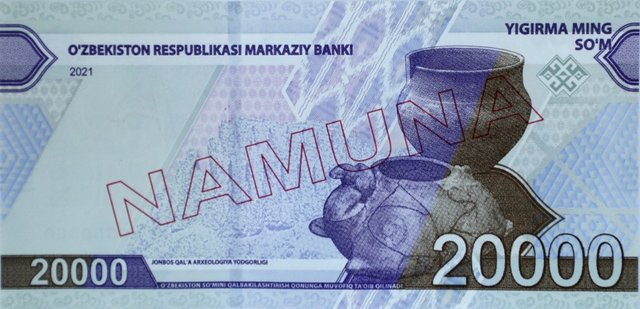
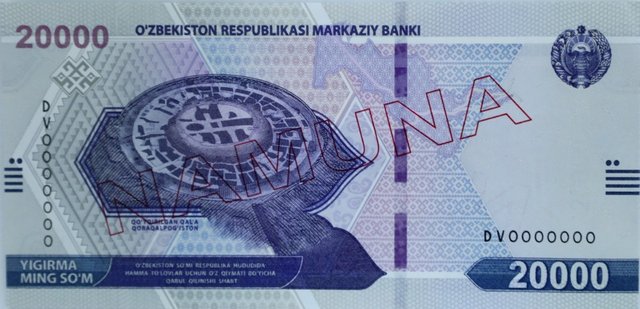
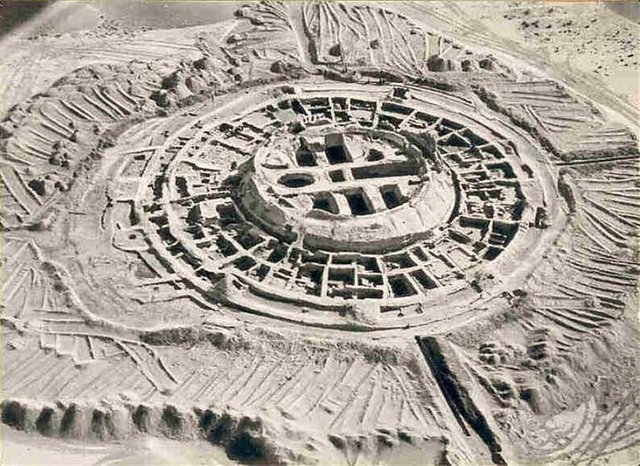
To begin with, in fact this object is not called Koi-Krylgan-kala (by the way, it translates as "Fortress of dead sheep" - don't ask why :)). And what it is called archaeologists and historians have yet to find out.
The history of this building goes back centuries. According to scientists, it was built in the IV-III centuries BC, then it was destroyed by the Saka tribes at the turn of the II century BC and was again inhabited in the III-IV centuries AD. It was discovered in 1938 by the Khorezm archaeological expedition led by Sergei Pavlovich Tolstov. Koi-Krylgan-kala was a large cylindrical two-story building, about 44 meters in diameter and up to 8 meters high.
Apparently, this complex was used as a tomb of kings and as a Zoroastrian temple. There is also an assumption that an observatory was located here.
Despite the fact that the complex was excavated more than 50 years ago, it hides many secrets that archaeologists have yet to unravel.
50,000 Sums - Palace of International Forums "Uzbekistan" (Tashkent)
Banknote of 2017. Size 144x78 mm. The predominant colors are purple, orange, dark green.
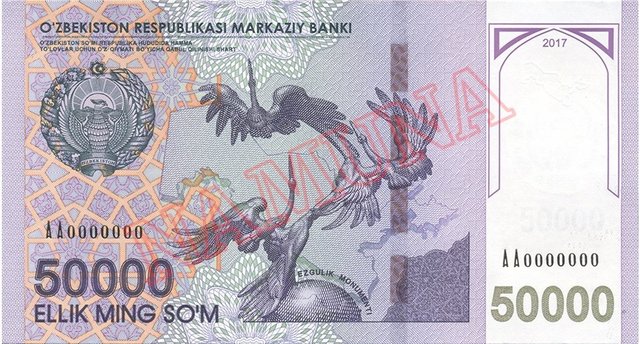
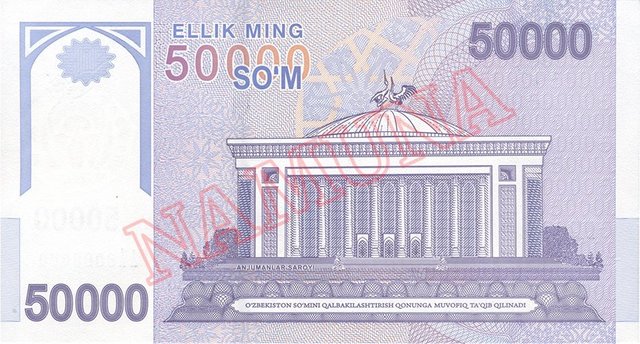
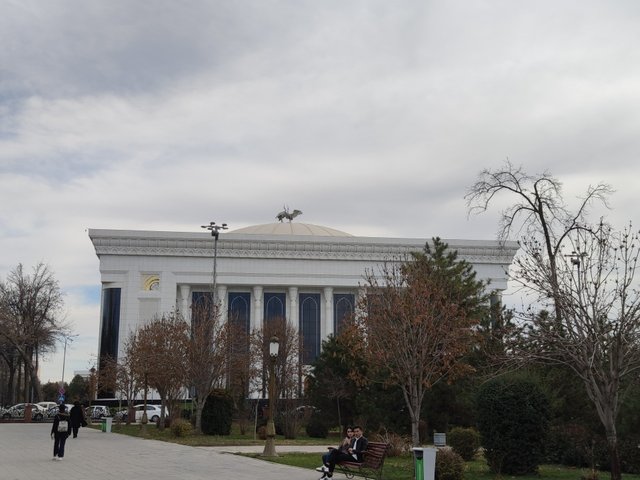
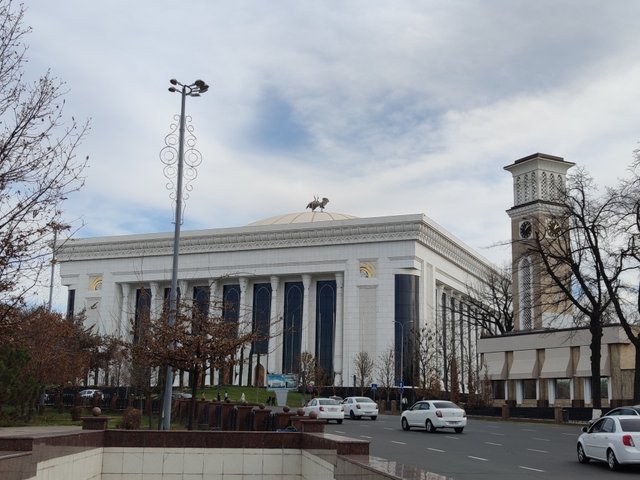
In 2017, it was obvious to everyone that even a 10,000-sum note was too small for our prices. Therefore, it was necessary to issue a denomination of a larger denomination – 50-thousandth. This banknote depicts the Palace of International Forums "Uzbekistan" or simply the Palace of Forums. A very controversial building, by the way. And yes, by the way, the same tiger-lions from the facade of the Samarkand Sherdor madrasah are depicted on the facade of the building.
It is huge and very expensive - it is 48 meters high. The capacity is over 2000 people, and the total area is over 9500 square meters. It was built in 2009. According to rumors, the construction cost more than $ 1 billion and, again, according to rumors, the disgraced daughter the First President - Gulnara Karimova had a hand in this project.
There were many laudatory reviews of this building in the press – like: "a majestic building that embodies national traditions and modern technologies, the pearl of the capital" and blah-blah-blah… But in reality - a huge, expensive and not particularly needed building. For the sake of which an important transport junction was demolished, inconveniences were created for the population. Again, according to rumors, because of this building a 150-years square was cut down - supposedly huge plane trees obstructed this palace and because of the spreading crowns, the cranes on the dome of the building were not visible ... Those who cut down this square would burn in hell ...
Well, in general, it is expensive, rich, pompous and especially not needed by anyone. I have never been there and am not eager to visit :)
100,000 Sums - Monument to Mirzo-Ulugbek and Ulugbek Observatory (Samarkand)
Banknote of 2019. Size 144x78 mm. The prevailing background colors of the front and back sides are light brown and blue.
At the moment, this is the highest denomination. And if you translate the denomination into dollars, then only $ 9.2 will come out ...
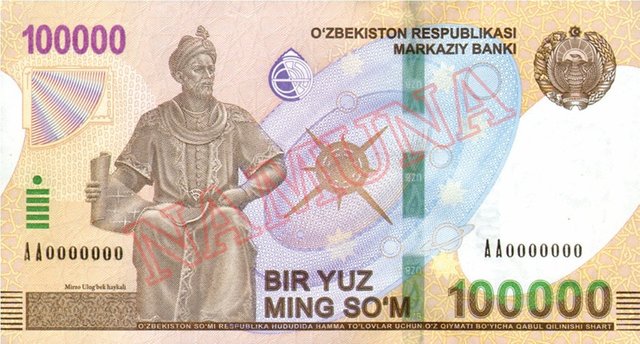
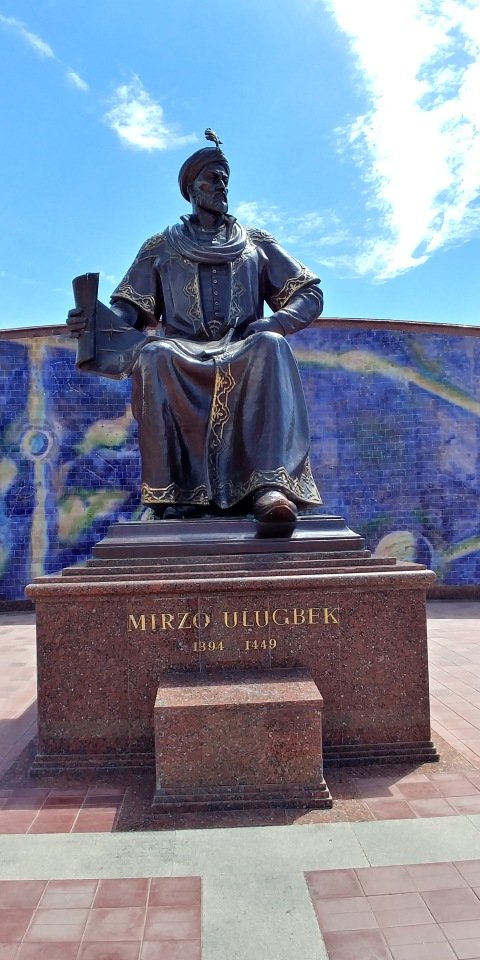
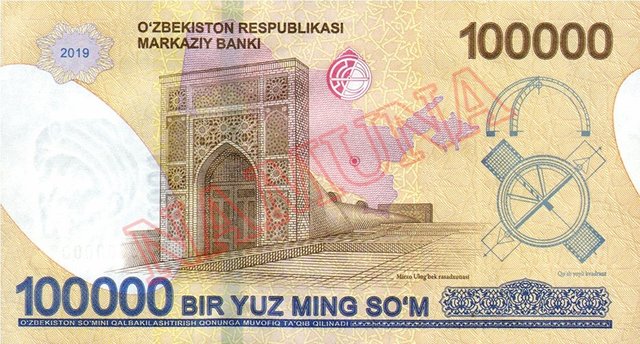
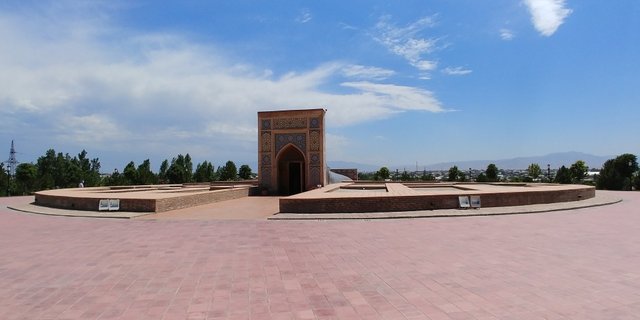
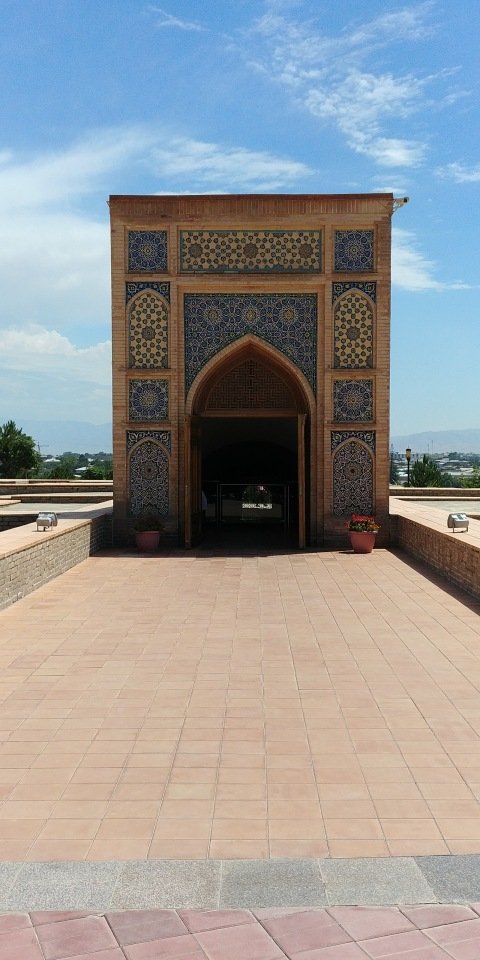
You have already seen the image of Tamerlane on the 500 Sum banknote. The 100-thousandth one depicts a monument to his grandson - the scientist-governor Ulugbek. And on the reverse side of the banknote is the entrance to the observatory. More details about the observatory can be found here.
A few words about Ulugbek: he was not only the ruler of Samarkand, the grandson of the formidable Tamerlane, but also an outstanding scientist-astronomer who determined the exact location of 1018 stars long before the invention of the telescope. He also calculated the speed of the Earth's revolution around the Sun with amazing accuracy. He lived in the XV century and the error in his calculations was less than a minute.
Ulugbek's merits in the dissemination and popularization of science in the medieval Islamic world are undeniable. His observatory was one of the best in the world. Its madrasah (Muslim educational institution) was one of the best in the East and was taught by outstanding scholars of that period. The catalog of stars compiled by him was present in every European observatory and was obligatory for study.
Being not only an outstanding scientist, Ulugbek was also a good ruler - the economic reform carried out by him made it possible to improve the well-being of the population. Unlike his great grandfather, Ulugbek during his reign (1411-1449) did not wage major wars, which contributed to the prosperity of the country.
The fate of Ulugbek was tragic - he was beheaded by the order of his own son, who wanted to take his throne. But people remember the ruler-scientist and Ulugbek monuments is biult in large cities of Uzbekistan, and large streets bear his name.
Ufff, finally finished. I thought I would write this post forever. I had to run around the city to update some of the photos. But, before I had time to finish the post, the news came out that the few days ago our Central Bank launched into circulation updated 50 and 100 thousand bills. Well, let them now wait for the second reissue of this post :). Considering the speed with which the Central Bank issues new banknotes, it will not be long to wait.
Well, "Mysterious Uzbekistan" is out of vacation and I hope to go somewhere with them soon ...
Happiness and good luck in the New year!
Congratulations @damm-steemit! You received the biggest smile and some love from TravelFeed! Keep up the amazing blog. 😍 Your post was also chosen as top pick of the day and is now featured on the TravelFeed.io front page.
Thanks for using TravelFeed!
@smeralda (TravelFeed team)
PS: You can now search for your travels on-the-go with our Android App. Download it on Google Play